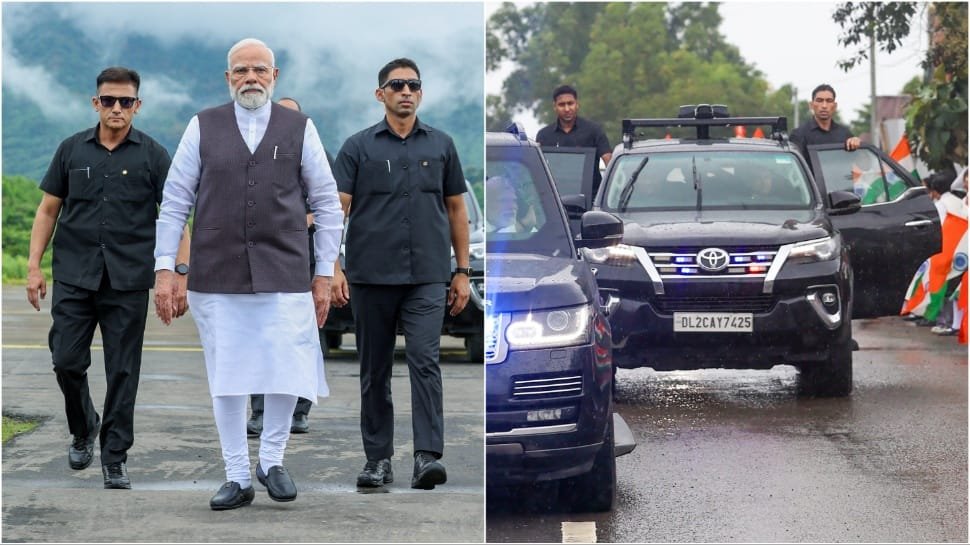Travel Guides & Articles
travel advisories libya: Danger tourism on rise: This African war-torn country gets 100,000 international visitors every year even after international travel warnings

Years of Conflict
Since the death of Muammar Gaddafi in 2011, Libya has faced ongoing political and military struggles. NATO-backed forces removed Gaddafi, but rival groups from the east and west have continued to fight for control. This situation has caused prolonged instability across the country.
International Travel Warnings
Several countries, including the United States and the United Kingdom, continue to warn citizens not to travel to Libya. The US Department of State has issued a Level 4 travel advisory. It mentions threats such as terrorism, crime, civil unrest, kidnapping, unexploded landmines, and armed conflict. The UK government also advises against all travel to Libya.
Also Read: Clair Obscur: Expedition 33: When will game release? Here’s release date, global launch timings, early access and preload
Tourist Numbers Remain Steady
Even with safety concerns, Libya receives around 100,000 international visitors each year, according to Travel and Tour World. Some countries have started easing travel restrictions to Libya due to hopes for improved conditions. Travelers like Hudson and Emily, who visited in 2024, reported feeling safe during their trip. They traveled with a bodyguard and visited sites like Leptis Magna and Tripoli.
Reports of Dangerous Experiences
Not all travel stories end smoothly. In May 2024, British tourist Daniel Pinto was held at gunpoint for seven hours by soldiers at a checkpoint. He spent 21 days exploring the country and described the experience as part of his interest in danger tourism. Pinto had previously visited countries like Iran and Syria.
Interest in Danger and Dark Tourism
Travelers like Pinto are part of a growing group exploring places with histories of disaster or conflict. Experts have observed an increase in visitors to locations known for violence or tragedy. These tourists often look for experiences outside of traditional travel options.
FAQs
Is it safe to visit Libya in 2025?
Libya remains under strong travel advisories. Safety cannot be guaranteed due to risks like armed conflict and civil unrest.
Why do tourists visit unsafe countries like Libya?
Some travelers seek unique experiences or are interested in history and culture. Others engage in danger tourism for the thrill.
Travel Guides & Articles
Delhi’s Bhai Dooj gift: Pink Card registration to begin from mid October; free bus travel for women

The Delhi government is set to launch the registration process for its Pink Card, a lifetime free bus travel pass for women, from mid-October, as a Bhai Dooj gift to the women of the national capital.According to a senior transport department official, the Pink Card will be valid for a lifetime and aims to make public transport easier and more accessible. The initiative will replace the existing paper-based ticket system with the ‘Saheli Smart Card’, described as a permanent and personalised pass designed to provide women with unrestricted and secure travel on government-run buses.He said registration for the card is expected to begin in October, allowing “Delhi’s daughters and sisters to avail unlimited free travel as a token of the government’s commitment towards their welfare.” The exact launch date and procedure will be finalised in a meeting scheduled for the coming week.The card will also enhance safety and reduce inconvenience by eliminating the need for daily paper tickets, offering instead a hassle-free smart card.Plans for the Saheli Smart Card were first outlined in July. At the time, officials confirmed that it would carry the holder’s name and photograph and would be available to women and transgender residents of Delhi aged 12 years and above. The card, issued under the National Common Mobility Card (NCMC) framework, will allow free travel on all DTC and Cluster buses and can also be recharged and used across other transit services.“To obtain the card, applicants must be bona fide residents of Delhi, aged 12 years or above, and have valid proof of address. They must register online through the DTC portal, select a participating bank, and complete full KYC verification at the chosen bank branch,” the official told PTI.The list of required documents includes Aadhaar, PAN, proof of residence in Delhi, a passport-size photograph, and any additional paperwork specified under the bank’s KYC norms. Once the KYC process is completed, the issuing bank will dispatch the card directly to the applicant’s registered address.The Delhi government has invited Expressions of Interest (EoI) from banks and financial institutions to support the card’s roll-out. Officials clarified that while the government will not charge users for the free travel scheme, banks may impose a small fee for issuing or maintaining the card. In the event of loss, the cardholder must inform the issuing bank, which may replace it under its own policies.Before it can be used, the card must be activated through the Automatic Fare Collection System (AFCS) of DTC. While topping up will enable use across other public transport services, the free travel facility will apply only to DTC and Cluster buses.“No card will be issued directly by DTC. Registration is completely online through the DTC portal, and cards are issued only after full KYC verification by the selected bank,” the official added.The chief minister has previously criticised the old pink ticket system, introduced under the AAP government, arguing that it was prone to corruption.
Travel Guides & Articles
Why Did PM Modi Travel By Road To Churachandpur After Ditching chopper, What Did He Say To A State Divided By Violence? | India News

Prime Minister Narendra Modi, who made his first trip to Manipur after the ethnic unrest started in 2023, drove into Churachandpur on Saturday after his scheduled helicopter flight was postponed because of incessant rain. The prime minister was initially supposed to fly from Imphal to the Kuki-dominated district but chose the 90-minute drive to reach the waiting crowds.
On his arrival, Modi thanked the people who defied the rain to receive him. “I was glad that I couldn’t take the helicopter because I had the chance to see the love and affection showered on the people of Manipur on the way. I bow my head to them with gratitude,” the prime minister told a gathering.
An Appeal for Peace and Reconciliation
Speaking at an event at the venue, PM Modi made a strong call for stability and peace in the war-torn state. He called on all ethnic groups, specifically the Meitei and Kuki people, to stop the violence and seek a peaceful future.
“I urge all the communities to walk on the path of peace to realize their aspirations and ensure their children’s future,” the prime minister said. “Today, I assure you that I am on your side. The government of India is on the side of the people of Manipur.”
Development Projects and Resettlement Plan
During his tour, PM Modi inaugurated 19 development projects worth around ₹7,300 crores whose foundation stones he laid. He said that these would enhance the living conditions of local people, particularly the hilltop tribal communities. The projects include improvements in urban infrastructure, roads, drainage, and healthcare facilities.
The prime minister also promised proper rehabilitation and resettlement of the almost 60,000 individuals uprooted by the conflict since May 2023. He reaffirmed the commitment of the central government towards restoring enduring peace and normalcy to the state.
ALSO READ | ‘Will Pave Way For Peace, Stability And Prosperity In Nepal’: PM Modi On Sushila Karki’s Appointment As PM
Travel Guides & Articles
Are UAE airports rejecting passengers over minor passport damage? Here’s why this matters for your travel plans | World News

Travellers flying from the UAE are being warned: even a slightly worn passport can now stop you from boarding. As immigration and airline checks tighten, minor wear and tear, such as frayed edges, water stains, or a scratched chip, is enough to get a valid passport rejected, regardless of visa status.
Passport wear can mean denied boarding, even with a valid visa
International travellers departing from Dubai, Abu Dhabi, and Sharjah are facing increased scrutiny over the physical condition of their passports. UAE-based airlines are now enforcing stricter rules, often stopping passengers at check-in if their passports show even minor damage, regardless of visa validity or passport expiry date. Common types of damage that can raise red flags include:
- Frayed corners
- Torn pages
- Water or coffee stains
- Loose binding
- Scratched or faulty data chips
- Peeling laminate
- Visible smudges, especially on the photo page
Authorities say these issues, though sometimes minor, may compromise embedded security features such as microchips, holograms, and machine-readable zones. If these features are damaged, passport scanners may fail, leading to suspicion of forgery or tampering by immigration officers. Airlines departing from the UAE are also held accountable. If a passenger is denied entry due to passport condition, the airline may face penalties or be required to bear the cost of deportation. This has made airlines extra cautious at the check-in stage, often barring travellers with visibly damaged passports from boarding at all.
Countries with the strictest passport integrity checks
While the UAE is leading this push for pristine passports, other countries are also enforcing similar measures. The following nations are particularly strict about the condition of travel documents:
- United Arab Emirates:
Passports with loose pages, damage to the binding, deep creases, or water exposure can be flagged. Airline staff are instructed to examine documents closely before allowing boarding. - Indonesia:
Even a 1-centimetre tear in any passport page may lead to refusal of entry. Indonesian immigration officers maintain a zero-tolerance approach toward damaged documents. - Thailand & Vietnam:
Any form of water damage, especially on the photo page, can result in entry denial. Cosmetic flaws are taken seriously. - United States:
Given the reliance on biometric verification and chip scanning, a scratched or non-functional chip can render a passport invalid. Border officials treat compromised passports as potential forgery risks. - Australia:
Immigration guidelines advise travellers to avoid flying with passports that show visible damage of any kind. Airline personnel have the discretion to deny boarding at check-in.
What counts as “damaged” and when to replace your passport
Officials generally split passport damage into two categories:
- Partially Damaged:
The personal details and photo remain legible, but the document has torn pages, stains, or surface damage. Even in this state, rejection is still possible at check-in or immigration. - Severely Damaged:
The passport’s photo or key information is obscured or unreadable. This renders the document unusable for international travel.
Even a partially damaged passport can lead to denial of boarding or entry. Travellers are strongly advised to renew their passport at the first signs of wear, before problems occur. Prevention is key: keeping the document dry, using a protective cover, and avoiding inserting papers or folding the passport helps maintain its integrity.
Why authorities are so strict, the risk of tampering
Modern passports are more than just identification; they are high-security documents embedded with:
- Microchips
- Holograms
- Machine-readable zones
Damage to any of these features can cause technical issues at automated border control gates or manual inspection points. A passport that fails to scan correctly could appear tampered with, triggering suspicion and potential detainment. Officials emphasize that the strict enforcement is to protect national security and maintain document integrity. With the rise in identity fraud and document forgery, immigration systems are designed to flag any inconsistencies, no matter how small.
-

 Business2 weeks ago
Business2 weeks agoThe Guardian view on Trump and the Fed: independence is no substitute for accountability | Editorial
-
Tools & Platforms1 month ago
Building Trust in Military AI Starts with Opening the Black Box – War on the Rocks
-

 Ethics & Policy2 months ago
Ethics & Policy2 months agoSDAIA Supports Saudi Arabia’s Leadership in Shaping Global AI Ethics, Policy, and Research – وكالة الأنباء السعودية
-

 Events & Conferences4 months ago
Events & Conferences4 months agoJourney to 1000 models: Scaling Instagram’s recommendation system
-

 Jobs & Careers2 months ago
Jobs & Careers2 months agoMumbai-based Perplexity Alternative Has 60k+ Users Without Funding
-

 Podcasts & Talks2 months ago
Podcasts & Talks2 months agoHappy 4th of July! 🎆 Made with Veo 3 in Gemini
-

 Education2 months ago
Education2 months agoVEX Robotics launches AI-powered classroom robotics system
-

 Education2 months ago
Education2 months agoMacron says UK and France have duty to tackle illegal migration ‘with humanity, solidarity and firmness’ – UK politics live | Politics
-

 Podcasts & Talks2 months ago
Podcasts & Talks2 months agoOpenAI 🤝 @teamganassi
-

 Funding & Business2 months ago
Funding & Business2 months agoKayak and Expedia race to build AI travel agents that turn social posts into itineraries



